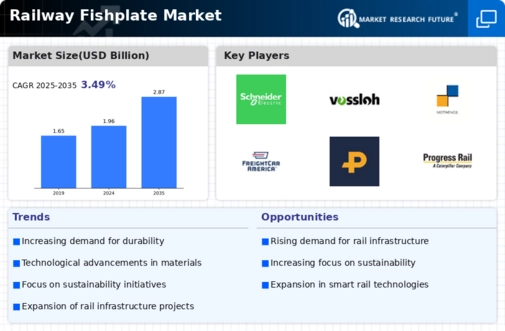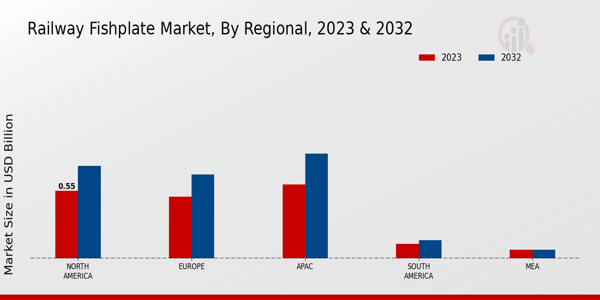Market Growth Projections
The Global Railway Fishplate Market Industry is projected to experience substantial growth over the next decade. With an anticipated market value of 1.96 USD Billion in 2024, the industry is expected to expand to 2.87 USD Billion by 2035. This growth trajectory suggests a robust demand for railway components, driven by factors such as infrastructure development, technological advancements, and increased freight transportation. The projected CAGR of 3.52% from 2025 to 2035 indicates a steady increase in market activity, reflecting the ongoing investments in railway infrastructure and the essential role of fishplates in maintaining track integrity.
Infrastructure Development
The ongoing global infrastructure development initiatives significantly drive the Global Railway Fishplate Market Industry. Governments worldwide are investing in modernizing and expanding railway networks to enhance connectivity and efficiency. For instance, in 2024, the market is projected to reach 1.96 USD Billion, reflecting the increasing demand for reliable railway components. This trend is particularly evident in emerging economies, where railway infrastructure is being prioritized to support economic growth. As countries strive to improve their transportation systems, the need for durable and efficient fishplates becomes paramount, thereby bolstering the market's expansion.
Technological Advancements
Technological advancements in railway infrastructure are poised to influence the Global Railway Fishplate Market Industry positively. Innovations in materials and manufacturing processes enhance the durability and performance of fishplates, which are crucial for maintaining track stability. For example, the introduction of high-strength steel and composite materials may lead to longer-lasting products. This shift towards advanced materials is likely to attract investments, as stakeholders recognize the potential for improved safety and reduced maintenance costs. As the industry evolves, the demand for technologically superior fishplates is expected to rise, contributing to the market's growth trajectory.
Increased Freight Transportation
The rise in freight transportation demand is a critical driver for the Global Railway Fishplate Market Industry. As global trade expands, railways are increasingly utilized for transporting goods efficiently over long distances. This trend is particularly pronounced in regions where rail networks are being optimized for freight operations. The market is anticipated to grow at a CAGR of 3.52% from 2025 to 2035, reflecting the increasing reliance on railways for logistics. Consequently, the demand for robust fishplates, which ensure the integrity of rail tracks under heavy loads, is expected to surge, thereby enhancing market prospects.
Urbanization and Population Growth
Urbanization and population growth are significant factors driving the Global Railway Fishplate Market Industry. As urban areas expand, the need for efficient public transportation systems becomes increasingly critical. Railways are often seen as a viable solution to alleviate congestion and provide reliable transit options. The projected market growth to 2.87 USD Billion by 2035 underscores the importance of railway infrastructure in urban planning. This trend necessitates the installation of durable fishplates to ensure the safety and reliability of rail systems, thereby propelling demand in the market. The interplay between urbanization and railway development is likely to shape future market dynamics.
Environmental Sustainability Initiatives
Growing environmental sustainability initiatives are influencing the Global Railway Fishplate Market Industry. Governments and organizations are prioritizing eco-friendly transportation solutions, with railways being a more sustainable option compared to road transport. This shift towards greener alternatives is likely to drive investments in railway infrastructure, including the production of environmentally friendly fishplates. As the industry adapts to meet sustainability goals, the demand for innovative solutions that reduce carbon footprints may increase. This trend not only supports market growth but also aligns with global efforts to combat climate change, further enhancing the appeal of railway transport.












